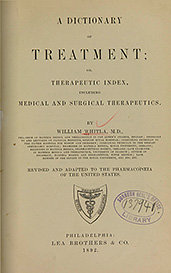-
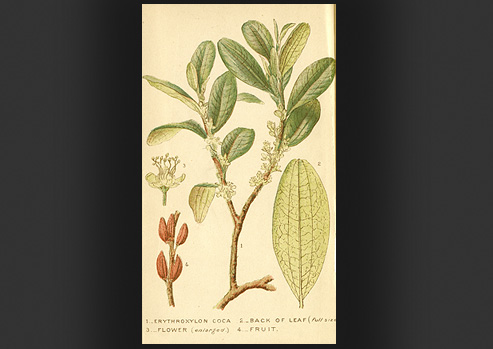
Erythroxylon coca in William Martindale, Coca and Cocaine: Their History and Medical and Economic Uses, and Medicinal Preparations, 1892
Courtesy National Library of Medicine
 BOTANICAL, Erythroxylon coca
BOTANICAL, Erythroxylon cocaIn 1860, the alkaloid cocaine was isolated from coca leaves. English pharmacist William Martindale published his study on coca in response to contemporary medical interest in the use of cocaine. He noted the history of the use of coca leaves among South American Indians who chewed the leaves to stave off hunger and exhaustion.
1._ ERYTHOXYLON COCA
2._ BACK OF LEAF (full size…
3._FLOWER (enlarged)
4._ FRUIT -
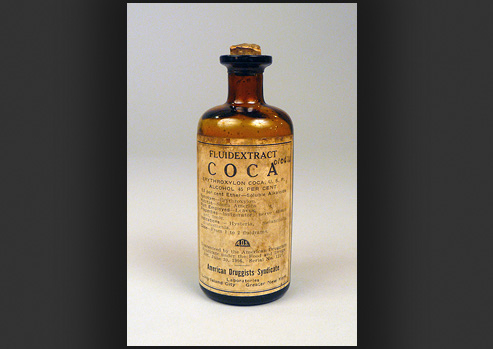
Fluid Extract Coca for medicinal use, ca. 1910
Courtesy National Museum of American History
 CURATIVE, Medical Marvel
CURATIVE, Medical MarvelCocaine was a breakthrough medical drug because of its application as a local anesthetic. By preventing pain even when the patient was awake, it made some types of surgery possible. Yet, physicians had begun to report on the drug’s tendency to create a habit, in which patients craved repeated doses.
Fluid Extract
COCA
ERYTHOXYLON COCA, U.S.P.
ALCOHOL 45 PER CENT
.5 per cent Ether- Soluble Alkaloids
Synonym- Erythroxylon
Habitat- South America
Part employed- Leaves
Properties-Invigorator, nerve stimulant, tonic
Indications- Hysteria, melancholia, …urasthenia
Dose- From 1 to 2 fluidrams
A.D.S
Guaranteed by the American Druggist Syndicate
Under the Food and Drugs Act. June 30, 1906 Serial No 121…
American Druggist Syndicate
Laboritories
Long Island City Greater New York -
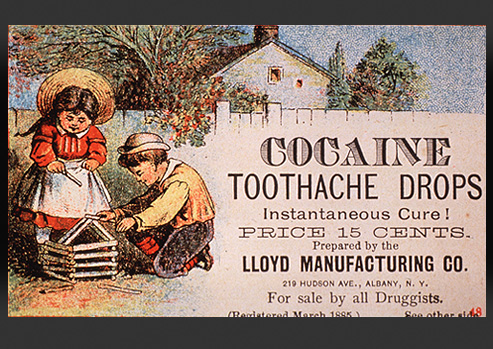
Advertisement for medicinal drops to relieve toothache, Lloyd Manufacturing Co., 1885
Courtesy National Library of Medicine
 MARKET, Instantaneous Cure!
MARKET, Instantaneous Cure!Before the 20th century, regulations did not require manufacturers of ready-made remedies to list ingredients in their medicines. Perhaps taking advantage of the popularity of the drug, Lloyd Manufacturing did advertise the cocaine in their toothache drops. The promised instantaneous relief was likely provided by the anesthetic properties of cocaine.
COCAINE TOOTHACHE DROPS
Instantaneous Cure!
PRICE 15 CENTS.
Prepared by the LLOYD MANUFACTURING CO.
219 HUDSON AVE., ALBANY, N.Y.
For sale by all Druggists.
(Registered March 1885.)
See other side. -
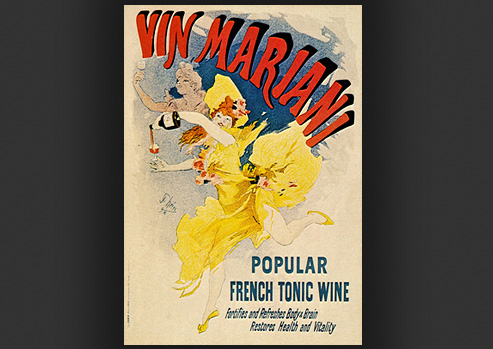
Jules Chéret, lithographer, advertisement for Vin Mariani, 1894 (reproduction 1981)
Courtesy National Library of Medicine
 MARKET, Tonic Wine
MARKET, Tonic WineIn the late 19th century, the typical cocaine user was a professional man who had been prescribed the drug or a physician administering his own doses. Coca wine was the most popular way to consume cocaine. Vin Mariani was the first coca wine product sold, and for a while, the most successful.
VIN MARIANI
POPULAR FRENCH TONIC WINE
Fortifies and Refreshes Body & Brian
Restores Health and Vitality -
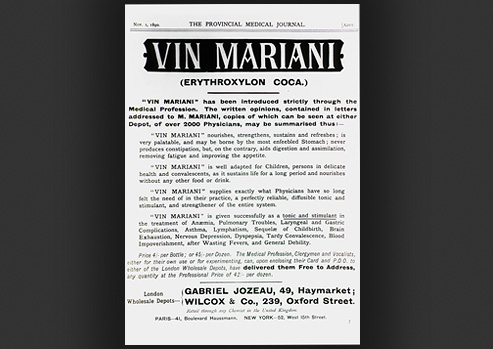
Advertisement for Vin Mariani in the Provincial Medical Journal, 1890
Courtesy National Library of Medicine
 MARKET, Tonic Wine
MARKET, Tonic WineIn the late 19th century, the typical cocaine user was a professional man who had been prescribed the drug or a physician administering his own doses. Coca wine was the most popular way to consume cocaine. Vin Mariani was the first coca wine product sold, and for a while, the most successful.
NOV. 1, 1890
THE PROVINCIAL MEDICAL JOURNAL
VIN MARIANI
(ERYTHROXYLON COCA.)“VIN MARIANI” has been introduced strictly through the Medical Profession. The written opinions, contained in letters addressed to M. MARIANI, copies of which can be seen at either Depot, of over 2000 Physicians, may be summarized thus:-
“VIN MARIANI” nourishes, strengthens, sustains and refreshes; is very palatable, and may be borne by the most enfeebled Stomach; never produces constipation, but, on the contrary, aids digestion and assimilation removing fatigue and improving the appetite.
“VIN MARIANI” is well adapted for Children, persons in delicate health and convalescents, as it sustains life for a long period and nourishes without any other food or drink.
“VIN MARIANI” supplies exactly what Physicians have so long felt the need of in their practice, a perfectly reliable, diffusible tonic and stimulant, and strengthener of the entire system.
“VIN MARIANI” is given successfully as a tonic and stimulant in the treatment of Anaemia, Pulmonary Troubles, Laryngeal and Gastric Complications, Asthma, Lymphatism, Sequelae of Childbirth, Brain Exhaustion, Nervous Depression, Dyspepsia, Tardy Convalescence, Blood Impoverishment, after Wasting Fevers, and General Debility.
Price 4/- per Bottle; or 45/- per Dozen. The Medical Profession, Clergymen and Vocalists, either for their own use or for experimenting, can, upon enclosing their Card and P.O.O. to either of the London Wholesale Depots, have delivered them Free to Address, any quantity at the Professional Price of 42/- per dozen.
London Wholesale Depots – GABRIEL JOZEAU, 49, Haymarket; WILCOX & Co., 239, Oxford Street.
Retail through any Chemist in the United Kingdom.
PARIS-41, Boulevard Haussmann. NEW YORK-52, West 15th Street. -
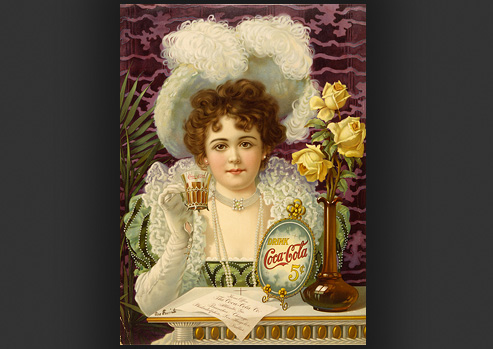
Advertisement for Coca-Cola, 1890s
Courtesy Library of Congress
 MARKET, Popular Refreshment
MARKET, Popular RefreshmentThe coca wine Vin Mariani was overtaken in popularity by Coca-Cola. Pharmacist John Pemberton created the drink as a non-alcoholic alternative to his Peruvian Wine Coca, after prohibition was adopted in Atlanta in 1886. By the 1890s the drink had become so popular that numerous imitations, with names alluding to their coca content—such as Koke, Cafe-Cola, and Kos-Kola—flooded the market.
-
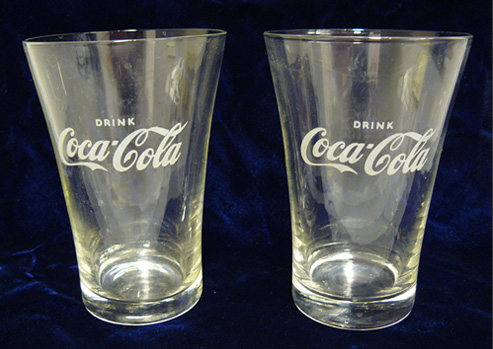
Coca-Cola glasses
Courtesy National Museum of American History
 MARKET, Popular Refreshment
MARKET, Popular RefreshmentThe coca wine Vin Mariani was overtaken in popularity by Coca-Cola. Pharmacist John Pemberton created the drink as a non-alcoholic alternative to his Peruvian Wine Coca, after prohibition was adopted in Atlanta in 1886. By the 1890s the drink had become so popular that numerous imitations, with names alluding to their coca content—such as Koke, Cafe-Cola, and Kos-Kola—flooded the market.
DRINK COCA-COLA
DRINK COCA-COLA -
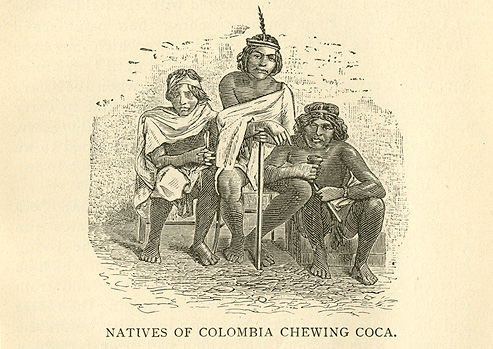
“Natives of Columbia chewing coca” from Angelo Mariani, COCA and its Therapeutic Application, 1896
Courtesy National Library of Medicine
 CONSUMER, Coca Custom
CONSUMER, Coca CustomSouth American Indians chewed coca leaves to stave off hunger and exhaustion. Waterfront laborers first sniffed cocaine in its powdered form to sustain their energy during long shifts loading and unloading ships. Employers distributed cocaine to miners, workers on plantations, construction crews, and factory employees, as a way to increase productivity.
-
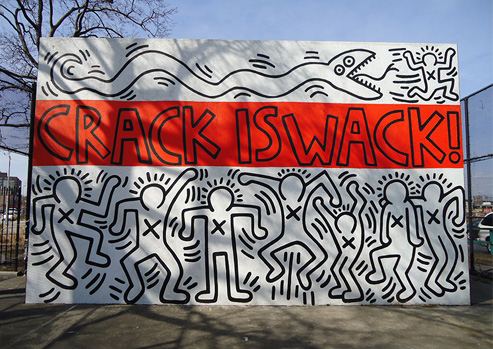
Crack is Wack playground mural, Keith Haring, 1986
Courtesy © Keith Haring Foundation and Jonathan Kuhn/New York City Parks & Recreation
 PROHIBITIVE, Crack is Wack
PROHIBITIVE, Crack is WackIn the 1980s, a smokeable form of cocaine, known as crack, gained notoriety. While rival gangs fought violently for control of the illicit market, sensational media coverage blamed a crack epidemic for a rise in crime. The ensuing panic led to long prison sentences for users as well as dealers.
-
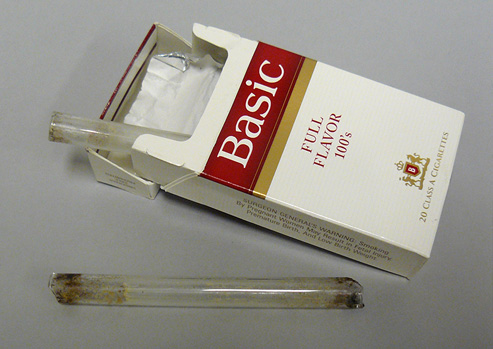
Crack, and pipes for smoking it, found in a cigarette box outside a drug and alcohol rehabilitation center, late 20th century
Courtesy National Museum of American History
 PROHIBITIVE, Crack is Wack
PROHIBITIVE, Crack is WackIn the 1980s, a smokeable form of cocaine, known as crack, gained notoriety. While rival gangs fought violently for control of the illicit market, sensational media coverage blamed a crack epidemic for a rise in crime. The ensuing panic led to long prison sentences for users as well as dealers.
Basic
FULL FLAVOR 100’S
20 CLASS A CIGARETTES
SURGEON GENERAL’S WARNING: Smoking By Pregnant Women May Result in Fetal Injury, Premature Birth, And Low Birth Weight.
In the late 19th century, physicians recommended cocaine for the treatment of hay fever, asthma, and melancholy, and as a cure for alcoholism and opiate addiction. At this time, the typical cocaine user was a professional man who had been prescribed the drug or a physician administering his own doses. Widespread use of the drug soon demonstrated the addictive potential of the substance. Nevertheless, cocaine’s low cost made it popular among poorer groups and young people in saloons and dance halls. This association with thrill-seekers and poor laborers fuelled successive waves of panic about the drug during the 20th century.


